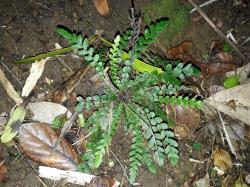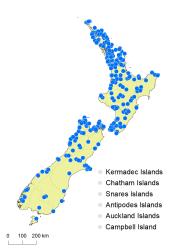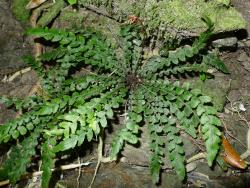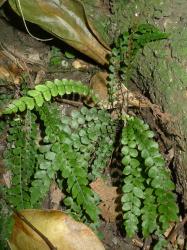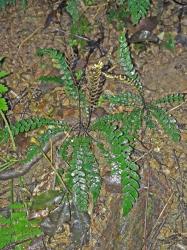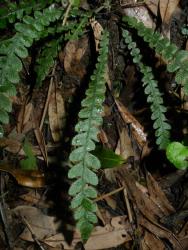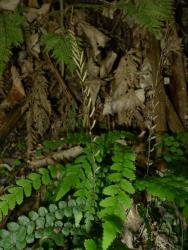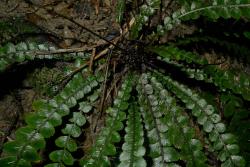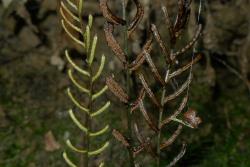- ≡ Lomaria membranacea Colenso ex Hook., Sp. Fil. 3, 34, t. 145 (1859)
- ≡ Spicanta membranacea (Colenso ex Hook.) Kuntze, Revis. Gen. Pl. 2, 821 (1891)
- ≡ Struthiopteris membranacea (Colenso ex Hook.) Ching, Sunyatsenia 5: 243 (1940)
- ≡ Austroblechnum membranaceum (Colenso ex Hook.) Gasper & V.A.O.Dittrich. in Gasper et al., Phytotaxa 275: 203 (2016)
- = Lomaria oligoneuron Colenso, Trans. & Proc. New Zealand Inst. 16: 346 (1884)
- = Lomaria intermedia Colenso, Trans. & Proc. New Zealand Inst. 19: 274 (1887)
- ≡ Blechnum hamiltonii C.Chr., Index Filic. 155 (1905) nom. nov. pro Lomaria intermedia Colenso 1887 (non Blechnum intermedium Link)
- ≡ Struthiopteris intermedia (Colenso) Ching, Sunyatsenia 5: 243 (1940)
- = Lomaria pygmaea Colenso, Trans. & Proc. New Zealand Inst. 25: 322 (1893)
- ≡ Blechnum pygmaeum (Colenso) C.Chr., Index Filic. 158 (1905)
- = Lomaria alternans Colenso, Trans. & Proc. New Zealand Inst. 28: 616 (1896)
- ≡ Blechnum alternans (Colenso) C.Chr., Index Filic. 150 (1905)
Rhizomes erect or prostrate, up to 60 mm long (in herbarium material), bearing scales. Rhizome scales linear to narrowly ovate, 2.5–6 mm long, 0.2–0.5 mm wide, dark brown, concolorous. Fronds strongly dimorphic; sterile fronds 45–370 mm long, forming a prostrate to suberect rosette; fertile fronds on same plant equalling or longer than sterile, 50–360 mm long, positioned centrally, held erect. Sterile fronds. Stipes 5–40 mm long, rarely to 80 mm in large fronds, red-brown, bearing a few scales proximally. Rachises yellow-brown, grooved adaxially, glabrous. Laminae 40–340 mm long, 8–40 mm wide, pinnatisect, linear to narrowly obovate, with a short apical segment, rarely to 45 mm wide in large fronds, similar colour on both surfaces, herbaceous to coriaceous, glabrous. Pinnae in 4–30 pairs, closely spaced, oblong or suborbicular, straight, gradually reducing to short flanges at the lamina base; the longest pinnae above the middle, 5–25 mm long, 4–10 mm wide, apices obtuse to rounded, margins dentate, bases adnate; the basal pinnae usually in opposite pairs. Veins free. Fertile fronds. Stipes 10–145 mm long. Laminae 40–240 mm long, 5–32 mm wide. Pinnae in 7–40 pairs, linear to narrowly oblong, falcate or straight, 3–24 mm long, 1–2 mm wide, reducing to tiny flanges at the lamina base. Sori and indusia in one row either side of costa, continuous along the length of the pinna.
Blechnum membranaceum is distinguished by its dimorphic fronds, free veins, pinnatisect, sterile laminae, and continuous sori. The sterile laminae are linear to narrowly obovate, with oblong to orbicular pinnae that are rounded to obtuse at their apices, dentate on the margins, and adnate at their bases. The basal pinnae are usually arranged in opposite pairs. The laminae are glabrous and a similar colour on both surfaces. The sterile fronds form a prostrate to suberect rosette with the fertile fronds held upright in the centre, the fertile usually longer than the sterile.
Blechnum membranaceum is very similar to B. chambersii, the two species hybridising in areas of overlap, but plants of B. membranaceum can be recognised by their generally narrower sterile laminae (8–40 mm wide, cf. 15–115 mm wide); obovate rather than elliptic outline; more obviously toothed pinnae, which are arranged in opposite pairs rather than alternately at the base of the lamina; and their fertile fronds, which are longer, not shorter, than the sterile fronds.
North Island: Northland, Auckland, Volcanic Plateau, Gisborne, Taranaki, Southern North Island.
South Island: Western Nelson, Sounds-Nelson, Marlborough, Westland, Canterbury, Otago, Southland, Fiordland.
Stewart Island.
Altitudinal range: 0–1350 m.
Blechnum membranaceum occurs in lowland and montane areas throughout the North Island from Te Paki to Wellington. It ranges from near sea level, up to 1250 m in the Huirau Range, Te Urewera, in the North Island. In the South Island it is widespread in lowland and montane areas, but absent from the drier parts of south Canterbury and Otago. It has a more scattered distribution south of Banks Peninsula, but reaches Stewart Island. It extends locally into subalpine areas, growing up to 1350 m in the Owen Range, north-west Nelson.
Blechnum membranaceum is a terrestrial fern found in podocarp, broadleaved and beech forest, under mānuka and kānuka, and in coastal scrub. It grows on clay banks, on stream banks and river flats, on rocks, on cliffs and rocky bluffs, in gullies, and on the ground, usually in more open forest. It is often found on limestone rock and around sinkholes.
There is evidence for hybridisation between Blechnum membranaceum and B. chambersii (see Blechnum ×aggregatum; Tindale 1960).
2n = 66 (Chambers 1954).
DNA sequences for a single chloroplast locus from Blechnum chambersii and B. membranaceum were identical or differed by one base pair (Shepherd et al. 2007). Wilson (2012), using DNA sequences from three chloroplast loci, found samples of B. membranaceum, B. norfolkianum from New Zealand, and Australian and New Zealand B. chambersii to differ by up to seven base pairs, but with no strongly supported relationships among them. The two studies indicate that all three taxa are very closely related.
In the absence of a type specimen, the synonymy of Lomaria pygmaea with B. membranaceum is based on historical precedent first determined by Cheeseman (1906), which is at least partly consistent with the protologue.



